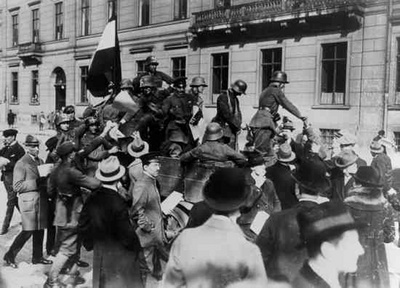
Historyguy.com
(1918-1945)
After Germany's defeat in World War I, the Kaiser's abdication set off a period of great internal conflict. The new democratic government, the so-called Weimar Republic, sought to instill democracy in a population that in many ways still sought a "strong man" type of ruler. Beset by foes from the political Left and Right, as well as by its own army and "Free Corps" militias, the government often resorted to brute force in order to survive. Eventually, of course, it did not survive, as the German people found themselves willing to listen to the leader of the National Socialist Worker's Party: Adolf Hitler.

Violence during Hitler's Beer Hall Putsch in 1923
Click on the blue links to access specific pages.
Kiel Mutiny (1918)-Naval Mutiny/Revolution
German Revolution (1918-1919)-Anti-Monarchy Revolution
Bavarian Revolution (Nov. 7, 1918-May 1, 1919)-Communist Revolution
Spartacist Revolt (Jan. 6-Jan. 15, 1919)-Communist Revolution
Rhineland Uprisings (1918-April 20, 1919)-Communist Revolution
Kapp Putsch (March, 1920)-Military Coup Attempt
Upper Silesia (Polish) Rebellion (1921)-Ethnic (Polish) Uprising
The Beer Hall Putsch (1923)-Hitler's Coup Attempt
Anti-Hitler Resistance (1933-1945)-Underground Partisan Resistance Against Hitler's Government
"The History Guy" is a Registered Trademark.
History Guy SiteMap